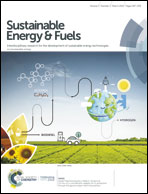Remarkably long-lived excited states of copper photosensitizers containing an extended π-system based on an anthracene moiety†
Abstract
An ideal photosensitizer should strongly absorb visible light over a broad range and exhibit long-lived excited states. Therefore, an anthracene moiety attached to a bipyridine sphere was chosen to study the impact of a carbon extended π-system in the back on the structural, electrochemical and photophysical properties of the resulting copper photosensitizers. Consequently, four novel homo- and heteroleptic Cu(I) complexes of the type [Cu(N^N)2]+ and [(P^P)Cu(N^N)]+ were prepared and fully characterized. The solid state structures possess a strong twist of the anthracene system due to sterical constraints. At the same time the absorption maxima are red-shifted and the excited states display unprecedented lifetimes up to 4 μs in acetonitrile stemming from different excitation processes unique for the anthracene moiety. The excited state properties were then further analyzed by transient absorption spectroscopy and DFT calculations. Moreover, it was found that the anthracene extension has a slight positive effect on the photocatalytic reduction of protons, which was selected as a model reaction to test the capability of these photosensitizers.



 Please wait while we load your content...
Please wait while we load your content...